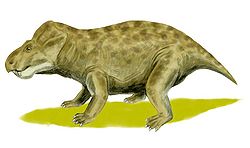
Kannemeyeria
Encyclopedia
Kannemeyeria was a large dicynodont
of the family Kannemeyeriidae
, one of the first representatives of the family, and hence one of the first large herbivores of the Triassic
. It lived during the later Early and early Middle part of the Triassic period
(from the late Olenekian
to the Middle Anisian
age).


 Kannemeyeria was about 3 m (10 ft) in length, about the size of an ox
Kannemeyeria was about 3 m (10 ft) in length, about the size of an ox
. It was well-adapted to living as a herbivore; it had a powerful beak and strong jaw muscles built for shearing plant material. Although it had a large head, it was lightweight due to the size of the eye sockets and nasal cavity
. It also had limb girdles which formed massive plates of bone that helped support its heavily-built body.
Various species of the genus Kannemeyeria are known from South Africa, Argentina, India, and (either this or a similar genus) China, and it can be assumed that, like many animals of this time, it had worldwide
distribution.
Dicynodont
Dicynodontia is a taxon of anomodont therapsids or mammal-like reptiles. Dicynodonts were small to large herbivorous animals with two tusks, hence their name, which means 'two dog tooth'...
of the family Kannemeyeriidae
Kannemeyeriidae
Kannemeyeriidae is a family of large, stocky, beaked and sometimes tusked dicynodonts. They were the dominant large terrestrial herbivores through most of the Triassic period...
, one of the first representatives of the family, and hence one of the first large herbivores of the Triassic
Triassic
The Triassic is a geologic period and system that extends from about 250 to 200 Mya . As the first period of the Mesozoic Era, the Triassic follows the Permian and is followed by the Jurassic. Both the start and end of the Triassic are marked by major extinction events...
. It lived during the later Early and early Middle part of the Triassic period
Triassic
The Triassic is a geologic period and system that extends from about 250 to 200 Mya . As the first period of the Mesozoic Era, the Triassic follows the Permian and is followed by the Jurassic. Both the start and end of the Triassic are marked by major extinction events...
(from the late Olenekian
Olenekian
In the geologic timescale, the Olenekian is an age in the Early Triassic epoch or a stage in the Lower Triassic series. It spans the time between 249.7 ± 0.7 Ma and 245 ± 0.7 Ma . The Olenekian follows the Induan and is followed by the Anisian.The Olenekian saw the deposition of a large part of the...
to the Middle Anisian
Anisian
In the geologic timescale, the Anisian is the lower stage or earliest age of the Middle Triassic series or epoch and lasted from 245 million years ago until 237 million years ago, approximately...
age).



Ox
An ox , also known as a bullock in Australia, New Zealand and India, is a bovine trained as a draft animal. Oxen are commonly castrated adult male cattle; castration makes the animals more tractable...
. It was well-adapted to living as a herbivore; it had a powerful beak and strong jaw muscles built for shearing plant material. Although it had a large head, it was lightweight due to the size of the eye sockets and nasal cavity
Nasal cavity
The nasal cavity is a large air filled space above and behind the nose in the middle of the face.- Function :The nasal cavity conditions the air to be received by the other areas of the respiratory tract...
. It also had limb girdles which formed massive plates of bone that helped support its heavily-built body.
Various species of the genus Kannemeyeria are known from South Africa, Argentina, India, and (either this or a similar genus) China, and it can be assumed that, like many animals of this time, it had worldwide
Pangaea
Pangaea, Pangæa, or Pangea is hypothesized as a supercontinent that existed during the Paleozoic and Mesozoic eras about 250 million years ago, before the component continents were separated into their current configuration....
distribution.

